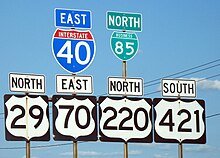
Back Peáž silnic Czech Multiplex (route) French 重用区間 Japanese Peáž ciest Slovak Värdväg Swedish การใช้เส้นทางร่วมกัน Thai 共線 (道路) Chinese

A concurrency in a road network is an instance of one physical roadway bearing two or more different route numbers.[1] When two roadways share the same right-of-way, it is sometimes called a common section or commons.[2] Other terminology for a concurrency includes overlap,[3] coincidence,[4] duplex (two concurrent routes), triplex (three concurrent routes), multiplex (any number of concurrent routes),[5] dual routing or triple routing.[6][7]
Concurrent numbering can become very common in jurisdictions that allow it. Where multiple routes must pass between a single mountain crossing or over a bridge, or through a major city, it is often economically and practically advantageous for them all to be accommodated on a single physical roadway. In some jurisdictions, however, concurrent numbering is avoided by posting only one route number on highway signs; these routes disappear at the start of the concurrency and reappear when it ends. However, any route that becomes unsigned in the middle of the concurrency will still be signed on most maps and road atlases.
- ^ Esri (March 4, 2014). "Realigning Concurrent Routes". ArcGIS Help 10.2 & 10.2.1. Esri. Retrieved April 8, 2014.
- ^ "Freeway Flaws: Fixing Them May Take Decades". Star Tribune. Minneapolis. June 3, 2005.
common sections ... 2 freeways share a single right-of-way
- ^ Esri (December 19, 2012). "Realigning Overlapping Routes". ArcGIS Resource Center. Esri. Retrieved April 8, 2014.
- ^ Office of Highway System Engineering (August 1995). "State Highway Routes Selected Information, 1994 with 1995 Revisions" (PDF). California Department of Transportation. Route 3. Archived from the original (PDF) on March 16, 2007. Retrieved March 7, 2012.
Coincident with Rte 299
- ^ Reichard, Timothy. "Guide to Highway Multiplexes". Central PA/MD Roads. Retrieved April 8, 2014.
- ^ Kanillopoolos, John J. (October 19, 1982). "Dual and Triple Routing on State Trunklines". Letter to Trunkline Numbering Committee. Lansing: Michigan Department of Transportation. Retrieved June 3, 2019 – via Wikisource.
- ^ Kanillopoolos, John J. (March 17, 1983). "Dual and Triple Routing on State Trunklines". Letter to Trunkline Numbering Committee. Lansing: Michigan Department of Transportation. Retrieved June 3, 2019 – via Wikisource.
© MMXXIII Rich X Search. We shall prevail. All rights reserved. Rich X Search